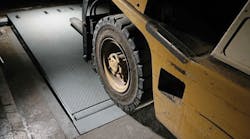The U.S. Census Bureau suggests that by 2016, one-third of the total U.S. workforce will be age 50 or older. Retirement is increasingly further on the horizon for many. As the workforce ages, chances for disability rise, especially in manufacturing and other physically challenging occupations.
For example, researchers from The Ohio State University conducted a small study to examine the health risks to forklift operators from vibration exposure at the loading dock1. The study examined several factors thought to potentially contribute to discomfort in employees’ lower extremities when driving stand-up forklifts in and out of trailers. These factors included the type of forklifts used and the surface condition between the warehouse floor and the bed of the truck. The study set out to determine if vibration exposure could be reduced if standard forklifts and dock levelers were replaced with new shock absorbing forklifts and newly reengineered dock levelers.
Data for the study was collected via accelerometers affixed via a self-adhesive wrap to the lower legs (over the shin bones), of three participants. The accelerometer measured the amount of tibial shock when crossing from the warehouse floor to the trailer. Additionally, the participants stood on an electronic scale while using the forklift to obtain the ground reaction force. Data was collected as the drivers entered and exited the trailer with both empty and moderate loads. The maximum speed of the forklifts was limited to 6 mph.
The results showed that tibial shock was reduced 16 percent when using existing forklifts with a newly reengineered dock leveler. The use of new forklifts resulted in a 30 percent decrease of tibial shock as compared to the old forklift and old dock leveler configuration. Using both the new forklift and the new dock leveler reduced the tibial shock by 58 percent.
This was excerpted from a whitepaper, “Dock Shock: The Impact of Whole-Body Vibration on an Aging Workforce,” published by Rite-Hite (www.ritehite.com).
1Lavender, Ph.D., S., & Mehta, M.S., J. (2012). Ergonomic evaluation of new dock levelers on the tibial shock experienced by fork truck operators when loading and unloading trailers. Unpublished raw data, Institute for Ergonomics, Ohio State University, Columbus, Ohio.



